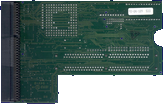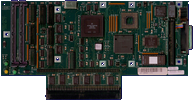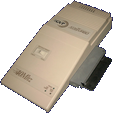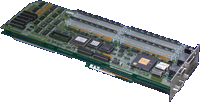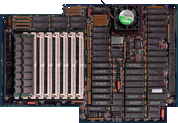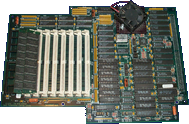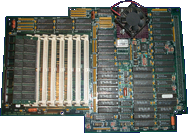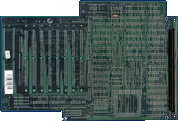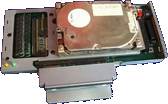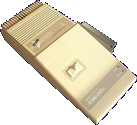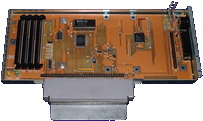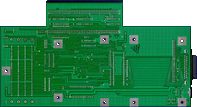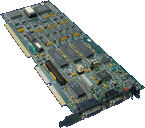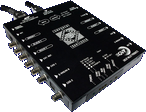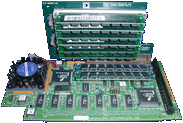Manufacturer “Great Valley Products”
37 expansions in database
Manufacturer Great Valley Products, USA | Date 1993 | Amiga A1200 | Interface trapdoor slot |
- Fast SCSI 2 DMA controller
- non standard SCSI connector - enables 2.5" drives to be connected inside the A1200
- optional external SCSI kit - external DB25 connector
- autoboot ROM (gvpscsi.device)
- memory
- two 64 pin SIMM sockets accept 8 MB RAM
- supports only special 1 or 4 MB GVP SIMMs
- notes
- optional 68882 PLCC FPU up to 50 MHz
- jumper settings
| J1 - | PCMCIA: OFF - compatible |
| J2 - | SIMM size: ON - 1 MB SIMMs, OFF - 4 MB SIMMs |
| CN2 - | FPU clock: 1-2 - from crystal, 2-3 - 14.3 MHz |
| J3 ON | J5, J6, J7, CN4 OFF | CN1, CN3 1-2 | - reserved |
- gvp_53.lzh
GVP-M
SCSI driver update v5.3
425 kB - gvpA1200scsi+ram.DMS
Installer's Heaven
install disk
405 kB
Manufacturer Great Valley Products, USA | Date 1993 | Amiga A1200 | Interface trapdoor slot | Autoconfig ID 2017 / 254 |
- processor
- 68EC030 @ 40 MHz PGA
- optional 68882 @ 40 MHz PGA or PLCC (depending on board revision)
- memory
- two 64 pin SIMM sockets accept 32 MB RAM
- supports only special 1, 4, 16 MB GVP SIMMs
- notes
- 68020 fallback mode via jumper
- jumper settings
| Jumper | Default | Description |
|---|---|---|
| J1 | OFF | ON - 68020 / OFF - 68030 |
| J2 | ON | Reserved |
| J3 | OFF | Reserved |
| J4 | OFF | Reserved |
| J5 | ON | ON - No 16MB SIMMS present / OFF - 16MB SIMMS present |
| J6 | OFF | Reserved |
Manufacturer Great Valley Products, USA | Date 1994 | Amiga A1200 | Interface trapdoor slot |
- processor
- 68EC030 @ 40 MHz or 68030 @ 50 MHz, PGA
- optional 68882 PGA, clocked at the same speed as the CPU
- memory
- two 64 pin SIMM sockets accept 32 MB RAM
- supports only special 1, 4 or 16 MB 60 ns GVP SIMMs
- SIMM sizes can be mixed, the bigger one goes to slot 1
- DMA Peripheral Port (DPP)
- optional A1291 SCSI kit (Stingray)
- SCSI 2 DMA controller (WD3393 or AM33C93A)
- DB25 external connector
- active termination
- FaaastROM driver (gvpscsi.device)
- supported by NetBSD
- never released modules
- 16 bit audio digitizer & playback unit
- realtime video digitizer
- notes
- Kickstart remapping
- battery backed up clock
- PCMCIA port still working with RAM sizes > 4 MB
- jumper settings
| J3 - | SIMM size: ON - 16 MB SIMM used, OFF - no 16 MB SIMM |
| J5 - | ROM: ON - enable |
| J6 - | SCSI: ON - enable |
| J1, J2, J4, J7 OFF | CN5 1-2 | - reserved |
- A1230II.dms
install disk
404 kB - gvp_53.lzh
GVP-M
SCSI driver update v5.3
425 kB - gvp1230.DMS
Installer's Heaven
install disk
406 kB - gvp1291.dms
Installer's Heaven
SCSI install disk
425 kB
Manufacturer Great Valley Products, USA | Date 1994 | Amiga A1200 | Autoconfig ID 2017 / 11 |
- SCSI controller
- A1291 is the optional SCSI controller for the A1230 Turbo+ II
- SCSI 2 DMA controller (WD3393 or AM33C93A)
- DB25 external connector
- active termination
- FaaastROM driver (gvpscsi.device)
- supported by NetBSD
Manufacturer Great Valley Products, USA | Date 1989 | Amiga A2000 | Interface CPU slot | Autoconfig ID 2017 / 8,9,13 |
- processor
- 68030 @ 16 / 25 / 28 / 33 / 50 MHz, PGA
- optional 68882 @ 16 - 50 MHz, PGA - can be clocked at different speed than the CPU
- optional memory daughterboards
- 68030-RAM8:
- eight 30 pin SIMM sockets accept 4 or 8 MB RAM
- supports only special 1 MB Nibble Mode SIMMs, they are more expensive than GVP SIMMs
- accepts SIMMs in groups of four
- 68030-RAM32: (from 1991)
- eight 64 pin SIMM sockets accept up to 8 or 20 MB RAM
- supports only special 1 or 4 MB, 60 ns GVP SIMMs
- 60 ns SIMMs are required for 50 MHz, 70 ns for 33 MHz, 80 ns for 25 MHz
- 16 - 33 MHz boards support 1 MB SIMMs only, possible configurations are 2, 4 and 8 MB
- 50 MHz boards support 4 MB SIMMs, possible configurations are 4, 8, 12, 16 and 20 MB
- using a 4 MB SIMM requires four 1 MB SIMMs to be installed in sockets 3 to 6, so the 4 MB SIMMs can only be installed into sockets 7 to 10
- optional IDE controller
- two autoboot ROM sockets
- to activate the IDE controller only the boot EPROM(s) (gvpat.device) has to be installed on the main board - the first version of the driver software required two EPROMs, later ones required only one
- does not support drives that has more than 1024 cylinders
- controller uses byte-swapped storaging, so the HDD will be unreadable on other controllers without that feature
- 40 pin internal IDE header
- A-Max II driver (gvpat.amhd) - requires gvpat.device v2.4 and A-Max v2.06
- notes
- autobooting requires at least Kickstart 1.3 - the autoboot ROM should not be installed with Kickstart 1.2
- two ROM sockets for UNIX boot ROMs that require an A2090A SCSI controller - these ROMs are compatible with those on the A2630
- 68000 fallback mode selectable by jumper
- the memory and IDE controller is also deactivated in fallback mode
- jumper settings - A3001
| Jumper | Default | Description |
|---|---|---|
| J4 | OPEN | Install to clock FPU from oscillator U2 |
| J5 | SHORTED | Remove to disconnect FPU from oscillator U1 |
| J6 | OPEN | Install to disable the 68030ís caches |
| J7 | OPEN | Install to disable the 68030ís MMU |
| J8 | OPEN | Install to enable Unix boot register |
| J9 | SHORTED | Remove to enable 68030 boot EPROMs |
| J10 | SHORTED | Remove for use in German 4-layer A2000ís |
| J11 | OPEN | Install to boot in 68000 mode |
| J12 | OPEN | Reserved |
| J13 | OPEN | Reserved |
| J14 | SHORTED | Reserved |
| J15 | OPEN | Reserved (AT interface) |
| J16 | SHORTED | Reserved (AT interface) |
- jumper settings - RAM8 board
| Jumper | Default | Description |
|---|---|---|
| J1 | OPEN | Reserved |
| J2 | OPEN | Reserved |
| J3 | SHORTED | Reserved |
| J4 | SHORTED | Reserved |
| J5 | SHORTED | Remove to enable full 8MB of 32-bit RAM |
| J6 | SHORTED | Reserved |
| J7 | OPEN | Reserved |
- A3001.dms
install disk (01.11.89)
320 kB - amiga.html#gvp
Ralph Babel
UNIX boot ROM image
1 kB - amiga.html#gvp
Ralph Babel
IDE ROM image
gvpat.device v4.1
10 kB
Manufacturer Great Valley Products, USA | Date 1991 | Amiga A2000 | Interface CPU slot | Autoconfig ID 2017 / 8,9,13 |
- processor
- 68030 @ 33 / 50 MHz, PGA
- 68882 @ 33 / 50 MHz, PGA - clocked separately from the CPU
- memory daughterboard (68030-RAM32)
- eight 64 pin SIMM sockets accept up to 8 or 20 MB RAM
- supports only special 1 or 4 MB, 60 ns GVP SIMMs
- 60 ns SIMMs are required for 50 MHz, 70 ns for 33 MHz, 80 ns for 25 MHz
- 16 - 33 MHz boards support 1 MB SIMMs only, possible configurations are 2, 4 and 8 MB
- 50 MHz boards support 4 MB SIMMs, possible configurations are 4, 8, 12, 16 and 20 MB
- using a 4 MB SIMM requires four 1 MB SIMMs to be installed in sockets 3 to 6, so the 4 MB SIMMs can only be installed into sockets 7 to 10
- IDE controller
- autoboot ROM (gvpat.device)
- does not support drives that has more than 1024 cylinders
- autobooting requires at least Kickstart 1.3 - the autoboot ROM should be removed with Kickstart 1.2
- controller uses byte-swapped storaging, so the HDD will be unreadable on other controllers without that feature
- 40 pin internal IDE header
- A-Max II driver (gvpat.amhd) - requires gvpat.device v2.4 and A-Max v2.06
- jumper settings
- main board (rev 7):
J4
ON
OFFJ5
OFF
ON- FPU clock
- from oscillator U2
- from oscillator U1J10
ON
OFFJ12
ON
OFFJ13
ON
OFFJ14
OFF
ON- clocking mode
- A2000-A german motherboard, 68000 must be removed
- A2000-B motherboardJ6 - MMU: ON - disable J7 - CPU clock: OFF - 50 MHz, ON - lower J9 - 68030 Boot code EPROMS (U23 and U25): OFF - enable J11 - 68000 fallback mode: ON - enable J15 - IDE autoboot EPROM (U34): ON - enable J17 - IDE autoboot EPROM type: ON - 27256, OFF - 27128 J18 - IDE drive: OFF - connected (with autoboot EPROM v3 or later) J1, J16
ONJ2
OFF
- reserved - memory board (rev 3):
J3
OFF
ONCN11
OFF
2-3CN13
ON
OFF
- 50 MHz
- lower clockJ5
ON
OFF- memory address of CN7-CN10 SIMMs
- Zorro II address space (with 1 MB SIMMs only)
- 0x01000000 (with 4 MB SIMMs only)J1, J4, J6, J8
ONJ2, J11
OFFCN12
1-2
- reserved
- notes
- two ROM sockets for UNIX boot ROMs that require an A2090A SCSI controller - these ROMs are compatible with those on the A2630
- the memory and IDE controller is also deactivated in 68000 fallback mode
- amiga.html#gvp
Ralph Babel
UNIX boot ROM image
1 kB - amiga.html#gvp
Ralph Babel
IDE ROM image
gvpat.device v4.1
10 kB
Manufacturer Great Valley Products, USA | Date 1992 | Amiga A500 | Interface side expansion port | Autoconfig ID 2017 / 11 |
- processor
- 68EC030 @ 40 MHz PGA
- optional 68882 @ 40 MHz PGA
- memory
- two 64 pin SIMM sockets accept 1, 2, 4 or 8 MB RAM
- supports special 1 or 4 MB GVP SIMMs
- SIMM sizes cannot be mixed
- hardware maprom
- SCSI 2 DMA controller
- FaaaST ROM SCSI driver
- 3.58 MB/s maximum transfer speed
- 50 pin internal SCSI connector
- DB25F external SCSI connector
- hard disk activity LED
- place for a 3.5" hard disk inside the case
- supported by Linux and NetBSD
- notes
- mini expansion slot for the optional GVP PC286 AT emulator
- connects to the side expansion port
- no passthrough connector
- disable switch on top of the case
- in 68000 fallback mode both the RAM and hard disk are deactivated
- external power supply
- built in fan
- jumper settings
| J1 - | MMU: ON - disable |
| J2 - | 68000 fallback mode: OFF - enable |
| J3 - | CPU cache: ON - disable |
| J9 - | autoboot: OFF - disable |
| J11 - | RAM: ON - not installed, OFF - installed |
| J13 - | SIMM size: ON - 4 MB, OFF - 1 MB |
| J4, J6 ON | J5, J7, J8, J10, J12 OFF | CN7, CN18 1-2 | CN8, CN11 2-3 | - reserved |
- amiga.html#gvp
Ralph Babel
SCSI ROM image
gvpscsi.device v4.15
16 kB - a530.dms
GVP-M
install disk
405 kB
Manufacturer Great Valley Products / Hydra Systems, USA | Date 1990 | Amiga A500A2000, A3000, A4000 | - - | Interface side expansion portZorro II | Autoconfig ID 2121 / 1 |
- Ethernet interface
- ANet is basically a Hydra AmigaNet distributed by GVP
Manufacturer Great Valley Products, USA | Date 1991 | Amiga any Amiga | Interface parallel port |
- DSS - Digital Sound Studio
- 8 bit stereo soundsampler
- up to 51.136 kHz sampling rate in mono and 42.613 in stereo
- 1991: left and right input level adjustment knobs and overload LEDs
- 1992:
- input level adjustment from software through 256 steps with automatic adjustment (auto gain) option
- low pass filter
- selectable line and microphone impedance
- work on up to 31 samples in memory
- load and save in RAW, IFF and Sonix with 1, 3 or 5 octaves
- stereo input (2× RCA)
- connects to the parallel port
Manufacturer Great Valley Products, USA | Date 1993 | Amiga any Amiga | Interface parallel port |
- DSS - Digital Sound Studio
- 8 bit stereo soundsampler
- up to 51.136 kHz sampling rate in mono and 42.613 in stereo
- adjustable input levels through 256 steps for both the right and left channels independently
- auto gain - automatic adjustment of input levels
- integrated low pass filter, programmable through 128 steps, also with automatic adjustment option
- work on up to 31 samples in memory
- load and save in RAW, IFF and Sonix with 1, 3 or 5 octaves
- controllable from ARexx
- audio connections:
- 1× stereo input (2× RCA)
- 1× microphone input (3.5 mm jack)
- connects to the parallel port
Manufacturer Great Valley Products, USA | Date 1992 | Amiga A2000 |
- RTG graphics card
- Inmos G364 CLT-RAMDAC
- 110 MHz pixel clock in 24 bit modes
- up to 80 kHz horizontal frequency
- up to 140 Hz vertical frequency
- 4 or 8 MB VRAM - 25 ns serial access, 80 ns random access
- the VRAM can be directly accessed by the 68030 or 68040 on the host Combo card
- eight SIMM sockets accept only special 1 MB GVP VRAM-SIMMs in groups of four
- 64 bit interleaved VRAM access
- up to 440 MB/s graphics data bus bandwidth with interleave
- max 576 MB/s blockwrite data bandwidth
- 50 MB/s CPU bus bandwidth - higher in burst mode
- double buffered true colour animations at 720×480 with 318 frames per second
- 64×64 pixels built-in hardware cursor
- screen modes
- 1600×1280×24
- 3200×2560×8
- notes
- connects to GVP G-Force Combo accelerators' 32 bit local bus
- HD15 VGA connector
- output control connector (mini DIN) for external monitor switch boxes
- external composite video (blackburst) input (SMB connector) allowing the board's output to be synchronised with an external video signal
- five BNC connectors
- EGS driver
Manufacturer Great Valley Products, USA | Date 1993 | Amiga A2000A3000, A4000 | - - | Interface Zorro IIZorro III | Autoconfig ID 2193 / 1,2 |
- RTG graphics card
- Cirrus Logic GD5426 or GD 5428 (VL bus)
- 85 MHz in 8 bit modes
- 45 MHz in 16 bit
- 28 MHz in 24 bit
- 15-75 kHz horizontal frequency
- up to 200 Hz vertical frequency
- 1 or 2 MB 70 ns DRAM
- four 512 kB chips in SOJ package
- screen modes
- 1600×1280×8 interlace
- 1152×864×16 interlace
- 800×600×24 non-interlace
- notes
- video signal passthrough, automatic monitor switching
- HD15 output and RB9 input connectors
- Zorro II / III autosensing
- does not work reliably with Buster rev. 9 - the Zorro II force option can be enabled in this case
- Picasso96, CyberGraphX 2, 3 & 4 and EGS drivers
- supported by Linux, NetBSD and OpenBSD
Manufacturer Great Valley Products, USA | Date 1992 | Amiga A2000 | Interface CPU slot | Autoconfig ID 2017 / 11 |
- processor
- 68EC030 @ 25 / 40 MHz or 68030 @ 50 MHz, PGA
- 68882 @ 25 / 40 / 50 MHz, PGA - clocked at the same speed as the 68030
- memory
- 25 MHz: 1 MB on board + three SIMM sockets gives 13 MB max
- 40 / 50 MHz: 4 MB on board + three SIMM sockets gives 16 MB max
- supports only special 64 pin 1 or 4 MB 60 ns GVP SIMMs
- maximum 8 MB is autoconfigured in the 16 MB address space, the exact amount is set by jumper
- the remaining memory is configured as extended memory by the FaaastROM driver
- Impact Series II SCSI controller
- 1.2 MB/s transfer speed
- direct DMA transfer to onboard Fast RAM
- FaaastROM SCSI driver (gvpscsi.device) - auto booting requires at least Kickstart 1.3
- DB25 external connector
- 50 pin internal header
- supported by Linux and NetBSD
- optional hard disk mounting kit allows installing any 1" drive on the back of the card
- notes
- 32 bit expansion bus for the EGS 110/24 graphics board
- if the EGS 110/24 is installed no place remains for the hard disk mounting kit
- 68000 fallback mode switchable either by software or jumper
- in 68000 fallback mode RAM and SCSI is also switched off
- Kickstart remapping
- jumper settings
- rev 3
J5
ON
OFF
ONJ6
OFF
ON
ONJ11
OFF
ON
OFFCN8
2-3
OFF
1-2- board type
- 25 MHz
- 40 MHz
- 50 MHzJ2 - 68000 fallback mode: OFF - enable J3 - MMU: ON - disable J9 - autoboot ROM: OFF - disable J12 - bank 1-2 memory address: ON - Zorro II address space, OFF - 0x01000000 J14 - SCSI drive: OFF - connected CN6 - HDD LED CN16 - FPU clock: 2-3 - uses CPU clock J4
ONJ7, J8, J10, J13, J15
OFFCN7, CN15
1-2CN14
2-3
- reserved - rev 4 (additional jumpers to rev 3)
J16 - DTACK pull-up for old A2000s: ON - enable CN15 - autoboot ROM version: 1-2 - v4.5; 2-3 - before v4.5 CN17
2-3
1-2-3
- 25 MHz, 50 MHz
- 40 MHz
- GForce2030-920914.dms
install disk (14.9.92)
gvpscsi.device v4.5
207 kB - GForce2030-921002.dms
install disk (2.10.92)
gvpscsi.device v4.13
406 kB - GForce2030.dms
install disk (13.9.90)
gvpscsi.device v3.7
343 kB - amiga.html#gvp
Ralph Babel
SCSI ROM image
gvpscsi.device v4.15
16 kB - combo030.dms
GVP-M
install disk
379 kB
Manufacturer Great Valley Products, USA | Date 1992 | Amiga A3000 | Interface CPU slot |
- processor
- 68040 @ 28 / 33 MHz
- MMU and cache disable jumpers
- memory
- eight 68 pin SIMM sockets for up to 8 MB RAM
- supports only special 1 MB non-multiplexed 40 ns GVP SIMMs
- accepts SIMMs in 1 MB increments
- burst RAM access can be enabled only when 4 or 8 MB RAM is installed
- fully autoconfiguring
- supports DMA to any A3000 peripheral
- notes
- software switchable 68030 fallback mode
- jumper settings
| JP10 OFF ON |
JP26 OFF OFF |
JP27 OFF ON |
JP28 ON OFF |
JP29 OFF OFF |
JP30 OFF ON |
JP31 ON OFF |
JP32 OFF OFF |
JP33 OFF ON |
- burst mode - enabled - disabled |
| JP1 - | MMU: OFF - enabled |
| JP2 - | cache: ON - enabled |
| JP22 - | CPU clock: ON - asynchronous, OFF - synchronous |
| JP23 - | CPU: ON - 68030, OFF - 68040 |
| JP24, JP25 - | RAM: ON - disabled |
| JP4, JP6, JP13-16, JP18, JP20 ON | JP3, JP5, JP7, JP9, JP12, JP19, JP21, CN5 OFF | CN3, CN4 2-3 | - reserved |
Manufacturer Great Valley Products, USA | Date 1992 | Amiga A2000 | Interface CPU slot | Autoconfig ID 2017 / 11,255 |
- processor
- 68040 @ 33 MHz
- memory
- four 64 pin SIMM sockets accept 64 MB RAM
- supports only special 4 or 16 MB GVP SIMMs
- SIMM sizes cannot be mixed
- 040 burst mode requires all four sockets to be filled up
- Kickstart remapping
- SCSI 2 DMA controller
- not Fast SCSI 2 - the same electronic as the GVP Series II controllers
- no termination power is fed to the external SCSI connector - active termination must be used
- 50 pin internal SCSI header
- DB25 external connector
- RDB compatible
- supported by Linux and NetBSD
- I/O
- RS232 compatible 9 pin buffered serial port
- 614140 bps max transfer speed
- Centronics parallel port
- selectable IBM / Amiga compatible mode
- notes
- 32 bit expansion bus for the EGS 110/24 graphics board
- jumper settings
| J4 - | SCSI drive: OFF - connected |
| J5 - | autoboot ROM: OFF - disable |
| J7 - | MMU: ON - disable |
| J20 - | SIMM size: ON - 4 MB, OFF - 16 MB |
| J22 - | burst mode: OFF - enable |
| J26 - | DTACK pull-up for old A2000s: ON - enable |
| CN9 - | parallel port mode: 1-2 - Amiga, 2-3 - IBM |
| J10, J16, J21, J24, J27 ON | J2, J3, J8, J15, J17, J18, J19, CN19 OFF | CN12, CN20 1-2 | CN11 2-3 | - reserved |
- GForce2040-140.dms
install disk v1.40 (18.2.93)
410 kB - GForce2040.bin
ROM image (1994)
32 kB - amiga.html#gvp
Ralph Babel
SCSI ROM image
gvpscsi.device v4.15
16 kB - combo040.dms
GVP-M
install disk v1.51
415 kB
Manufacturer Great Valley Products, USA | Date 1992 | Amiga any Amiga | Interface RGB port |
- genlock and sound mixer
- switchable dual composite input - software switching between two separate composite input sources for fast cuts between video - or a single high quality Y/C input
- Composite to Y/C transcoder provides simultaneous composite, Y/C, and RGB outputs
- the RGB output can be switched to provide YUV output for professional recording equipment
- realtime ProcAmp controls allow adjustment of hue, saturation, brightness, contrast, sharpness, filtering, gain, and more
- SECAM to PAL conversion in VCR quality
- keyer modes include Amiga only, external video only, overlay, inverse overlay, and control of Amiga ECS and AGA special effects
- audio processor allows software switching and mixing control of two separate monaural audio sources, with full control over volume, treble, and bass
- can operate as an adjustable electronic RGB color splitter for direct use with the NewTek Digi-View or other slow-scan video digitizers
- works with the Display Enhancer and FlickerFreeVideo boards for simultaneous genlocked video and deinterlaced Amiga graphics output
- complete software control with full ARexx and CLI interfaces
- AmigaDOS 1.3, 2.x, 3.x compatible
- does not require separate power supply
- inputs:
- 2× Composite, RCA jacks
- 1× Y/C, mini-DIN
- 1× Component (RGB), DB25 (from Amiga DB23)
- 2× monoaural audio, RCA jacks
- 1× control (from Amiga DB9 joystick port)
- outputs:
- 1× Composite, RCA jacks
- 1× Y/C, mini-DIN
- 1× Component (RGB or YUV), DB23
- 1× monoaural audio, RCA jacks
- video input standards (user selectable):
- NTSC-M
- PAL-B/G/I
- SECAM-L/B/G/K
- video output standards (Amiga dependent):
- NTSC-M
- PAL-B/G/I
Manufacturer Great Valley Products, USA | Date 1991 | Amiga A2000 | Interface CPU slot | Autoconfig ID 2017 / 11 |
- processor
- 68030 @ 22 / 33 MHz, QFP
- 68882 @ 22 / 33 MHz, PLCC surface mounted
- the CPU and FPU are clocked at the same speed by the same oscillator
- memory
- 22 MHz: 1 MB preinstalled, expandable to 13 MB RAM
- 33 MHz: 4 MB preinstalled, expandable to 16 MB RAM
- three 64 pin SIMM sockets accept 1 or 4 MB GVP SIMMs
- Impact Series II SCSI controller
- WD33C93 controller IC
- direct DMA transfer to onboard Fast RAM
- FaaastROM SCSI driver (gvpscsi.device) - auto booting requires at least Kickstart 1.3
- DB25 external connector
- 50 pin internal header
- optional hard disk mounting kit allows installing any 1" drive on the back of the card
- jumper settings
| J10 ON OFF | J13 OFF ON | - memory address - outside Zorro II address space - Zorro II address space (with 1 MB SIMMs only) |
| J3 - | MMU: ON - disable |
| J4 - | SCSI drive: OFF - connected |
| J6 - | 68000 fallback mode: OFF - enable |
| J9 - | autoboot ROM: ON - disable |
| J7, J12, J15, J17, J18, J19, J22 ON | J8, J11, J14, J16, J20 OFF | J21, CN7, CN8 1-2 | - reserved |
- amiga.html#gvp
Ralph Babel
SCSI ROM image
gvpscsi.device v4.15
16 kB - combo030.dms
GVP-M
install disk
379 kB
Manufacturer Great Valley Products, USA | Date 1988 | Amiga A2000, A3000, A4000 | Interface Zorro II | Autoconfig ID 2017 / 1,2,3 |
- SCSI 2 DMA controller
- WD 33C93 controller IC
- autoboot ROM (optional on early versions) - autobooting requires at least Kickstart 1.3
- has no autoboot disable jumper - the autoboot ROMs have to be removed under Kickstart 1.2
- 50 pin internal SCSI header
- DB25 external connector
- hard disk activity LED connector
- no place for mounting a hard disk on the card
- memory
- 32 DIP sockets accept up to 1 MB RAM
- accepts 256k×1 DIPs
- early revisions support 512 kB or 1 MB configurations
- late revisions support 0 or 1 MB configurations
- DMA between drive and 4 kB onboard SRAM
- late revisions: depending on the RAM configuration, one of two PAL chips has to be installed ( 0 MB = PAL with red label, 1 MB = PAL with blue label) in location U74
- jumper settings
| Jumper | Configuration | Setting |
| J3 | Memory Size | 0 or 512 kB - ON 1 MB - OFF |
- ImpactSCSI.pdf
Installation and User's Guide (english)
5.4 MB
- amiga.html#gvp
Ralph Babel
SCSI ROM image
gvpscsi.device v3.15
16 kB - GVP-SeriesI_v1.3.dms
Installer's Heaven
install disk v1.3
356 kB
Manufacturer Great Valley Products, USA | Date 1988 | Amiga A2000, A3000, A4000 | Interface Zorro II | Autoconfig ID 2017 / 1,2,3 |
- SCSI 2 DMA controller
- WD 33C93 controller IC
- autoboot ROM (optional on early versions) - autobooting requires at least Kickstart 1.3
- has no autoboot disable jumper - the autoboot ROMs have to be removed under Kickstart 1.2
- 50 pin internal SCSI header
- DB25 external connector
- hard disk activity LED connector
- no place for mounting a hard disk on the card
- memory
- sixteen DIP sockets accept up to 2 MB RAM
- early revisions:
- accepts 256k×4 DIPs in groups of eight
- supports 0, 1 and 2 MB configurations
- later revisions:
- accepts 1M×1 DIPs in groups of 16
- supports only 0 and 2 MB configurations
- DMA between drive and 16 kB onboard SRAM
- jumper settings
| Jumper | Configuration | Setting |
| J1, J2 | Memory Size | 0 MB - ON ON 1 MB - ON OFF 2 MB - ON OFF |
| J4 | Autoboot | Enable / Disable |
- ImpactSCSI.pdf
Installation and User's Guide (english)
5.4 MB
- amiga.html#gvp
Ralph Babel
SCSI ROM image
gvpscsi.device v3.15
16 kB - GVP-SeriesI_v1.3.dms
Installer's Heaven
install disk v1.3
356 kB
Manufacturer Great Valley Products, USA | Date 1988 | Amiga A2000, A3000, A4000 | Interface Zorro II | Autoconfig ID 2017 / 2,3 |
- SCSI 2 DMA controller
- WD 33C93
- optional autoboot ROM - autobooting requires at least Kickstart 1.3
- DMA between drive and 8 kB onboard SRAM
- place for a 3.5" hard disk on the card
- 50 pin internal SCSI header
- DB25 external connector
- hard disk activity LED connector
- no memory expansion
- jumper settings
| Jumper | Configuration | Setting |
| J2 | Autoboot | Enable - ON, Disable - OFF |
- ImpactSCSI.pdf
Installation and User's Guide (english)
5.4 MB
- amiga.html#gvp
Ralph Babel
SCSI ROM image
gvpscsi.device v3.15
16 kB - GVP-SeriesI_v1.3.dms
Installer's Heaven
install disk v1.3
356 kB
Manufacturer Great Valley Products, USA | Date 1990 | Amiga A2000, A3000, A4000 | Interface Zorro II | Autoconfig ID 2017 / 10,11 |
- SCSI 2 DMA controller
- WD 33C93 @ 7 MHz
- 3.58 MB/s transfer speed
- FaaastROM SCSI driver (gvpscsi.device) - autobooting requires at least Kickstart 1.3
- autoboot disable jumper
- RDB compatible
- place for a 3.5" hard disk on the card
- 50 pin internal SCSI header
- DB25 external connector
- hard disk activity LED connector
- no termination power
- no memory expansion
- A-Max II driver (gvpscsi.amhd)
- supported by Linux and NetBSD
- Impact2000_SeriesII.pdf
user manual
555 kB
- amiga.html#gvp
Ralph Babel
SCSI ROM image
gvpscsi.device v4.15
16 kB - gvp.impact.seriesii.DMS
Installer's Heaven
install disk
372 kB
Manufacturer Great Valley Products, USA | Date 1989 | Amiga A2000, A3000, A4000 | Interface Zorro II | Autoconfig ID 2017 / 2,3 |
- SCSI 2 DMA controller
- WD 33C93
- autoboot ROM is standard but optionally can be replaced with advanced autoboot ROM supporting removable media devices
- has no autoboot disable jumper - the autoboot ROMs have to be removed under Kickstart 1.2
- place for a 3.5" hard disk on the card
- 50 pin internal SCSI header
- DB25 external connector
- hard disk activity LED connector
- memory
- two 30 pin SIMM sockets accept 2 MB RAM
- accepts 1 MB SIMMs
- DMA between drive and 16 kB onboard SRAM
- amiga.html#gvp
Ralph Babel
SCSI ROM image
gvpscsi.device v3.15
16 kB - GVP-SeriesI_v1.3.dms
Installer's Heaven
install disk v1.3
356 kB
Manufacturer Great Valley Products, USA | Date 1990 | Amiga A2000, A3000, A4000 | Interface Zorro II | Autoconfig ID 2017 / 10,11 |
- SCSI 2 DMA controller
- WD 33C93A @ 14 MHz
- 3.58 MB/s transfer speed
- FaaastROM SCSI driver (gvpscsi.device) - autobooting requires at least Kickstart 1.3
- autoboot disable jumper
- RDB compatible
- place for a 3.5" hard disk on the card
- 50 pin internal SCSI header
- DB25 external connector
- hard disk activity LED connector
- no termination power
- A-Max II driver (gvpscsi.amhd)
- supported by Linux and NetBSD
- memory
- eight 30 pin SIMM sockets accept 8 MB RAM
- accepts SIMMs in groups of two, giving 2, 4, 6 or 8 MB configurations
- this memory is technically not Zorro II memory - data is DMA-d from the HD as normal, but not via the Zorro bus for added speed
- jumper settings
| J5 OFF OFF ON OFF OFF |
J6 OFF ON OFF OFF ON |
J7 ON OFF OFF ON OFF |
J8 OFF OFF OFF ON ON |
J9 ON ON ON OFF OFF |
- memory - 0 MB - 2 MB, CN10-CN11 - 4 MB, CN10-CN13 - 6 MB, CN10-CN15 - 8 MB, CN10-CN17 |
| J3 - | autoboot ROM |
| J4 - | SCSI drive |
| J10-J12 - | SCSI ID |
- Impact2000_SeriesII.pdf
user manual
555 kB
- amiga.html#gvp
Ralph Babel
SCSI ROM image
gvpscsi.device v4.15
16 kB - gvp.impact.seriesii.DMS
Installer's Heaven
install disk
372 kB
Manufacturer Great Valley Products, USA | Date 1991 | Amiga A2000, A3000, A4000 | Interface Zorro II | Autoconfig ID 2077 / 9 |
- 16 DIP sockets for 2 MB RAM
- six 30 pin SIMM sockets for up to 8 MB RAM
- accepts 1 or 4 MB SIMMs
- suppports 2, 4, 6, 8 MB configurations
- fully auto-configuring
- jumper settings
| J5 OFF ON OFF OFF ON |
J6 ON OFF OFF ON OFF |
J7 OFF OFF ON OFF OFF |
J8 OFF OFF ON ON OFF |
J9 ON ON OFF OFF OFF |
J10 OFF OFF OFF OFF ON |
- 2 MB (DIPs only) - 4 MB (DIPs + 1 MB SIMMs in CN12-CN13) - 6 MB (DIPs + 1 MB SIMMs in CN12-CN15) - 8 MB (DIPs + 1 MB SIMMs in CN12-CN17) - 8 MB ( no DIPs, 4 MB SIMMs in CN12-CN13) |
Manufacturer Great Valley Products, USA | Date 1989 | Amiga A2000, A3000, A4000 | Interface Zorro II | Autoconfig ID 2017 / 1,2,3 |
- SCSI 2 DMA controller
- WD 33C93 controller IC
- autoboot ROM (optional on early versions) - autobooting requires at least Kickstart 1.3
- has no autoboot disable jumper - the autoboot ROMs have to be removed under Kickstart 1.2
- 50 pin internal SCSI header
- DB25 external connector
- hard disk activity LED connector
- no place for mounting a hard disk on the card
- memory
- eight 30 pin SIMM sockets accept up to 8 MB RAM
- accepts 1 MB SIMMs in groups of two
- DMA between drive and 16 kB onboard SRAM
- amiga.html#gvp
Ralph Babel
SCSI ROM image
gvpscsi.device v3.15
16 kB - GVP-SeriesI_v1.3.dms
Installer's Heaven
install disk v1.3
356 kB
Manufacturer Great Valley Products, USA | Date 1993 | Amiga A2000, A3000, A4000 | Interface Zorro II | Autoconfig ID 2017 / 10,11 |
- SCSI 2 DMA controller
- the GVP A4008 is a name variation of the Impact A2000 Series II HC+8
- Impact2000_SeriesII.pdf
user manual
555 kB
- amiga.html#gvp
Ralph Babel
SCSI ROM image
gvpscsi.device v4.15
16 kB - a4008.dms
GVP-M
install disk
385 kB
Manufacturer Great Valley Products, USA | Date 1990 | Amiga A500 | Interface side expansion port | Autoconfig ID 2017 / 10,11 |
- SCSI 2 DMA controller
- 3.58 MB/s transfer speed
- FaaasT ROM SCSI driver (gvpscsi.device) - autobooting requires at least Kickstart 1.3
- RDB compatible
- place for a 3.5" hard disk inside the case
- 50 pin internal header
- DB25 external connector
- supported by Linux
- A-Max II driver (gvpscsi.amhd)
- memory
- four 30 pin SIMM sockets accept 8 MB RAM
- accepts 1 or 4 MB 120 ns SIMMs
- supports 2, 4 or 8 MB configurations
- the 4 MB configuration requires four 1 MB modules, a 4 MB module is not sufficient
- fully autoconfiguring
- notes
- connects to the side expansion port
- has no passthrough connector
- stylish design matches the A500
- disable switch
- hard disk activity LED
- external power supply
- built in fan
- mini expansion slot for the optional PC emulator card
- problems may arise with the combination of A500, 8372A Agnus and an internal memory expansion with CPU or Gary adaptor - a trace has to be cut to solve the problem
- jumper settings
| J5 OFF OFF ON ON |
J6 OFF ON OFF OFF |
J7 ON OFF OFF OFF |
J8 ON ON ON OFF |
J9 OFF OFF OFF ON |
J12 1-2 1-2 1-2 2-3 |
- memory - 0 MB - 2 MB, CN9-CN10 - 4 MB, CN9-CN12 - 8 MB, CN9-CN10 |
- amiga.html#gvp
Ralph Babel
SCSI ROM image
gvpscsi.device v4.15
16 kB - a500hd8.dms
GVP-M
install disk
373 kB
Manufacturer Great Valley Products, USA | Date 1988 | Amiga A500 | Interface side expansion port | Autoconfig ID 2017 / 1,2 |
- SCSI 2 DMA controller
- DMA to onboard 16 kB buffer
- RDB compatible
- place for a 3.5" hard disk inside the case
- 50 pin internal header
- DB25 external connector
- Impact A500-2/X
- optional autoboot / RAM board
- 2 MB zero wait-state RAM
- sixteen 1M×1 DIPs
- autoboot ROM - autobooting requires at least Kickstart 1.3
- notes
- connects to the side expansion port
- has no passthrough connector
- hard disk activity LED
- built in fan
- external power supply
- ImpactSCSI.pdf
Installation and User's Guide (english)
5.4 MB
- amiga.html#gvp
Ralph Babel
SCSI ROM image
gvpscsi.device v3.15
16 kB
Manufacturer Great Valley Products, USA | Date 1989 | Amiga A500 | Interface side expansion port | Autoconfig ID 2017 / 1,2 |
- SCSI 2 DMA controller
- DMA to onboard 16 kB buffer
- onboard autoboot ROM - autobooting requires at least Kickstart 1.3
- autoboot disable switch
- RDB compatible
- place for a 3.5" hard disk inside the case
- 50 pin internal header
- DB25 external connector
- memory
- four 30 pin SIMM sockets accept up to 4 MB RAM
- accepts 1 MB SIMMs
- supports 2 or 4 MB configurations
- fully autoconfiguring
- notes
- connects to the side expansion port
- has no passthrough connector
- hard disk activity LED
- built in fan
- external power supply
Manufacturer Great Valley Products, USA | Date 1991 | Amiga A2000, A3000, A4000 | Interface Zorro II, video slot | Autoconfig ID 2017 / 32 |
- multi-function video card
- framebuffer:
- provides 12 or 24 bits of colour information to an Amiga screen
- 1.5 MB as two banks of 12 bit RAM
- double buffered 12 bit (4096 colours) animations or a single buffered 24 bit (16.7 million colours) image
- 768×625 (PAL) or 768×525 (NTSC) maximum resolution
- framegrabber:
- realtime digitizing at up to 25 fps
- freeze, grab and store 12 or 24 bit full screen live RGB video in real time frame grabbing
- composite and Y/C video requires an RGB splitter or the optional Video Interface Unit
- flicker fixer:
- duplicates and enhances the A3000's display enhancer circuitry
- even de-interlaces external live video
- the HD15 VGA output is software switchable between 15 and 31 kHz
- works only in 12 bit mode
- picture in picture:
- freeze, resize, move or scale live incoming RGB video in a window
- reverse-PIP - place a fully functional movable and scalable Workbench window on full screen live video
- works in 12 bit mode only
- genlock:
- separate composite and component (RGB + sync) genlocks
- three genlock modes - controlled by a switch on the back of the board:
- Amiga graphics only
- keyed source - allows external video to show through the background
- full external - direct feed of the RGB signal so it can be seen what the camera is pointing at or the live video to show through every colour but the background
- separated RGB, composite and Y/C inputs
- composite and Y/C outputs
- optional Video Interface Unit:
- connects to the 26 pin I/O connector of the IV24
- built-in RGB splitter converts the composite and Y/C inputs into RGB
- separate RGB, 2× composite, Y/C, external reference, key and remote control inputs
- composite, Y/C and key outputs
- software selectable sync source (external reference, composite 1 or 2, Y/C)
- optional Video Interface Unit / Component Transcoder:
- all features of the Video Interface Unit
- connects to the 26 pin I/O and the HD15 VGA connector of the IV24
- additional component input and output (Y, B-Y, R-Y), RGB output
- connects to the inline Zorro and video slots of the A3000
- can be installed in the A2000 with an optional video slot adaptor card
- does not require a time base corrector unless broadcast quality is required
- software: Scala, Caligari 24, MacroPaint, IV24 utilities
- VHI driver
- IV24-Caligari_1.dms
Caligari IV24, disk 1
285 kB - IV24-Caligari_2.dms
Caligari IV24, disk 2
379 kB - IV24-Caligari_3.dms
Caligari IV24, disk 3
382 kB - IV24-Install.dms
Install disk
fye.library v37.201
242 kB - IV24-Install_Upgrade_20S.dms
Upgrade disk v2.0S
fye.library v37.302
259 kB
Manufacturer Great Valley Products, USA | Date 1994 | Amiga A4000 | Interface Zorro II, video slot | Autoconfig ID 2017 / 32 |
- multi-function video card
- all features of the original Impact Vision 24
- twice as fast in the A4000 as the original version, performance remains the same when used in an A3000 or A2000
- software: ImageFX 1.5, EGS SpectraPaint
- VHI driver
Manufacturer Great Valley Products, USA | Date 1993 | Amiga A2000, A3000, A4000 | Interface Zorro II | Autoconfig ID 2017 / 11 |
- serial and parallel interface
- one DB25 parallel port
- two buffered DB9 serial ports
- 1-614400 bps serial transfer speed
- ST16C552 interface chip with 16 byte buffer
- MIDI sub-port for optional MIDI expansion box - 1 IN, 3 Out, 1 Thru
- expansion port for optional RS422 or second RS232 kit
- parallel port can be set to be Amiga or IBM compatible
- Amiga: 5V supplied on pin 14
- IBM: no power supplied
- works together with G-Force parallel ports
- supports multiple IOExtenders in one machine
- not compatible with ParNet
- supported by Linux
Manufacturer Great Valley Products, USA | Date 1992 | Amiga A500 |
- IBM AT emulation
- a special version of ATonce Plus designed for the GVP mini slot
- 80286 @ 16 MHz
- optional 80C287 FPU
- 512 kB PC RAM
- can use the Amiga's RAM
- Hercules, CGA, EGA / VGA monochrome, T3100 video modes
Manufacturer Great Valley Products, USA | Date 1992 | Amiga A2000, A3000, A4000 | Interface Zorro II | Autoconfig ID 2017 / 11 |
- integrated voice mail and fax system
- Yamaha YTM401 voice-fax chip
- sending and receiving of faxes at 2400-9600 bps
- auto fax detection
- audio record and play back at 9600 Hz, 8 bit
- two RCA connectors: line in for digitizing, line out for audio monitoring of incoming calls
- two RJ11 telephone jacks: one to the phone line, the other to a local telephone
- audio can be recorded and played back through the local telephone too
- an attached fax machine can be used as scanner
- voice compression feature
- record and play back of voice and fax messages remotely
- schedule sending faxes
- multiple PhonePaks can be installed for multiple phone lines
- multiple PhonePaks can share mail boxes
- in order to use the PhonePak in an A3000 or A4000, a Zorro II RAM expansion has to be added in another slot because these machines have problems with Zorro II DMA to Chip RAM
- PhonePak-101.dms
install disk v1.01
578 kB - PhonePak_Messages.dms
messages disk
673 kB - ppak1.dms
GVP-M
install disk 1 v2.4
440 kB - ppak2.dms
GVP-M
install disk 2 v2.4
661 kB - ppak25.dms
GVP-M
v2.5 upgrade
441 kB - ppak3.dms
GVP-M
install disk 3 v2.4
508 kB
Manufacturer Great Valley Products, USA | Date 1994 | Amiga A4000 | Interface CPU slot |
- processor
- 68040 @ 33 / 40 MHz
- memory
- two 64 pin SIMM sockets accept 32 MB RAM
- supports only special 1, 4 or 16 MB GVP SIMMs
- optional RAM board
- six additional SIMM sockets accept 96 MB RAM
- gives a total of 128 MB RAM
- one 4 MB SIMM is factory installed
- optional Fast SCSI 2 module
- max 10 MB/s transfer speed
- note
- the optional RAM and SCSI modules do not fit into A3000 / A3000T / A4000T
Manufacturer Great Valley Products, USA | Date 1995 | Amiga A4000 | Interface CPU slot | Autoconfig ID 2017 / 22 |
- processor
- 68060 @ 50 MHz
- memory
- four 72 pin SIMM sockets accept 128 MB RAM
- supports 4, 8, 16, 32 MB SIMMs, 60 ns
- 64 bit interleaved RAM access to pairs of SIMMs
- Fast SCSI 2 controller
- NCR 53C710
- 16 byte (128 bit) burst DMA transfers
- 50 pin internal SCSI connector
- no external connector
- the tekscsi2.device is not NSD compliant, it autoboots FFS partitions only - it looks for filesystems in the Kickstart ROM, but it does not care about filesystems loaded into the RDB area
Manufacturer Great Valley Products, USA | Date 1994 | Amiga A2000, A3000, A4000 | Interface Zorro II |
- Time Base Corrector
- infinite window time base corrector using 8 bit 4:2:2 CCIR-601 professional quality all digital video signal processing
- realtime 24 bit video framegrabber / framebuffer for use as a digital video stillstore or signal generator
- full transcoding between Composite and Y/C (SVHS) input and Composite and Y/C (SVHS) output
- full processing amplifier (ProcAmp) control for correcting or adjusting incoming video on the fly quickly and professionally (hue, brightness, contrast, saturation)
- realtime programmable video special effects generator featuring solarization, strobing, pseudo colour, monochrome effects, and more
- NTSC / PAL / SECAM signal standards conversion to NTSC / PAL for integration into worldwide video environments automatically
- ImageFX: direct editing and manipulation in the framebuffer
- optional full SMPTE / EBU timecode receiver / generator (encoding / decoding / striping) - VITC (Vertical Interval Time Code) and LTC (Longitudinal Time Code) can be read and written
- optional digital comb filter (cleans up Composite for Y/C output and fixes cross colour by splitting the Composite signal into separate chroma and luma signals as if it were a true Y/C input) provides true wide band 5.5 MHz Composite video performance
- inputs and outputs reside on an adaptor cable
- inputs: Y/C, two Composite Video, external key signal, sync reference signal, Longitudinal Time Code (LTC)
- outputs: Y/C, Composite Video, Longitudinal Time Code (LTC)
- the Composite and Y/C inputs can be connected simultaneously and hot switched with software without having to play with cable connections
- convert the two Composite inputs into a single Y/C input, providing two switchable Y/C inputs
- up to five TBCPlus cards can be installed in a single Amiga and independently controlled
- will not overload the power supply when the maximum of five TBCPlus units are installed
- works in 30 Hz, 29.97 Hz, 25 Hz, 24 Hz drop frame and color frame modes, can put a SMPTE burn-in window anywhere over the video
- Memory
- two 30 pin SIMM sockets for frame buffer memory
- 1 MB installed as standard, expandable to 2 MB for improving special effects
- accepts only 1 MB GVP SIMMs
- two 30 pin SIMM sockets for 0, 2 or 8 MB standard Zorro II Fast RAM - supports only 1 MB or 4 MB SIMMs in pairs
- the Fast RAM expansion has nothing to do with the performance of the TBC Plus, it doesn't increase the frame buffer capacity - it is meant for A3000 and A4000 machines which may have problems with Zorro II DMA to Chip RAM
- Jumper Settings
| Jumper | Pin 1 - 2 | Pin 2 - 3 | Default |
| JP1 | Reserved | Reserved | 1 - 2 |
| JP2 | BBI unterminated | BBI terminated | 2 - 3 |
| JP3 | No SMPTE | SMPTE Installed | 1 - 2 |
| JP5 | Reserved | Reserved | 2 - 3 |
| JP6 | Reserved | Reserved | 2 - 3 |
| JP11 | Reserved | Reserved | 1 - 2 |
| MB Installed | JP7 | JP8 | JP9 | JP10 |
| 0 | 2 - 3 | 2 - 3 | 2 - 3 | 2 - 3 |
| 2 | 2 - 3 | OFF | 1 - 2 | 2 - 3 |
| 8 | 1 - 2 | 1 - 2 | 2 - 3 | 1 - 2 |
- TBCPlus_Extras-100.dms
extras disk v1.00
69 kB - TBCPlus_Install-100.dms
install disk v1.00
gvptbc.device v6.2 (29 Nov 1993)
291 kB - YCrCb101.lha
Aminet
YCrCb ImageFX loader
5 kB - ycbcrdatatype.lha
Aminet
YCrCb.datatype v1.0
4 kB - tbcextra.dms
GVP-M
utilities disk
68 kB - tbcinst.dms
GVP-M
install disk
291 kB
 Amiga Hardware Database
Amiga Hardware Database






